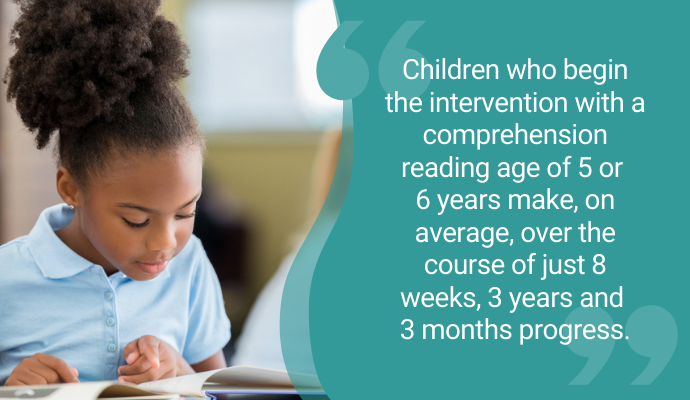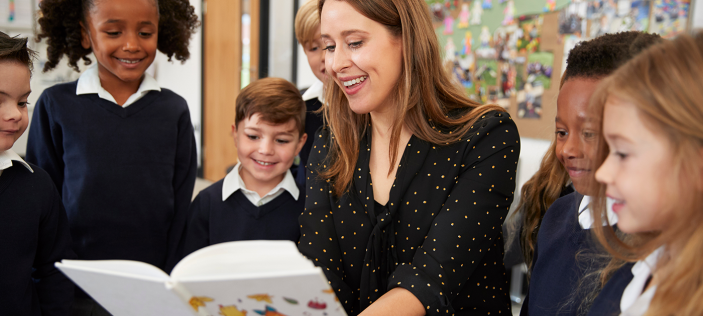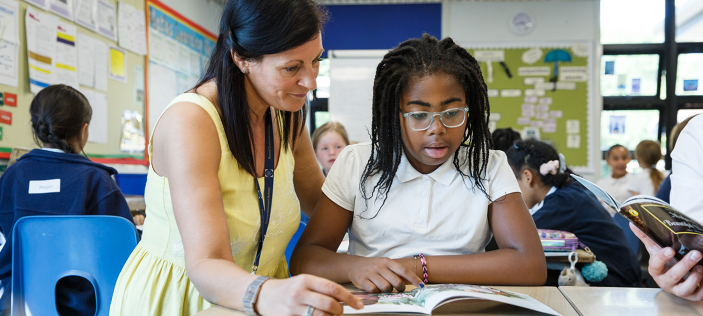
The KS2 Herts for Learning Reading Fluency Project is now in its 6th year and we are currently working with our 14th cohort. We are incredibly proud of the fact that more than 2000 children have been involved with project and are still reading.
Prior to our work back in 2017, there was little being said about reading fluency as a specific strand of our reading pedagogy in the UK. Members of the team had been exploring and discussing a wide range of research leading to a chapter on the topic in our KS2 Guided Reading Toolkit. Some of our early blogs shared this focus: Do you sound good to listen to? (or ‘fluency: reading’s best-kept secret weapon’) and As easy as A B fluenCy! The latter blog considers references to fluent reading in the DFE exemplification videos. The EEF recognised that whilst direct teaching of fluency was beneficial to reading achievement, there was little evidence to support that assertion.
We are proud to claim to have somewhat altered this landscape with our project. The project strategies have drawn hugely on the work of scholars in the states, Dr. Timothy Rasinski in particular, who have long recognised that specific fluency instruction has a huge impact on reading success, especially for our struggling readers.
The project is more popular than ever and the need to swiftly adapt the training to function remotely due to the challenges of the pandemic, has allowed its reach to extend even further geographically. Delegates from all over the UK have now taken part. We now also run the project for KS1 and KS3 cohorts .
We have recently had the opportunity to share the outcomes of this work with other national providers and have used the opportunity to take stock, to consider not only what we know now, but also where we plan on going next.
The Reading Fluency Project is just that, a project. As a result, it evolves. The data (as measured by the York Assessment of Reading Comprehension) has been consistently high since the project’s inception in 2017. The tweaks made have ensured that the strategies are more accessible and straightforward for teachers and pupils to follow, and the CPD itself is as effective and supportive as possible.
Data for KS2/3 reading assessments combined:
Participants on the project are asked to use the York Assessment for Reading Comprehension (YARC) to assess the pupils at the start and end of the 8 week intervention.
Approximately 2200 pupils across KS2-3 have now taken part in the project.
We have YARC data for approximately 1400* pupils
% making 6 months+ progress: 84% - KS2/3
% making 12 months+ progress: 72% - KS2/3
It is worth noting that in general, pupils with the lowest starting points make the most progress on this intervention. Children who begin the intervention with a comprehension reading age of 5 or 6 years make, on average, over the course of just 8 weeks, 3 years and 3 months progress. The overall average progress made by participating pupils is 2 years, 3 months. This data is broadly consistent with each cohort.
At KS1, we have YARC data for approximately 400 pupils* The average comprehension increase in just 8 weeks for our KS1 pupils is 1 year 5 months.
Interestingly, we have started to gather accuracy scores too. The project was designed to swiftly support children with improving their comprehension skills, but we are delighted by the fact that there is a stable improvement in reading accuracy across the cohorts too, from KS1-3. On average in just 8 weeks, pupils’ accuracy at KS1 increases by an average of 11 months, and by an average of 13 months for KS2/3. This is the number of words that the pupil is able to accurately read at the start of the intervention vs the end of the intervention.
*We do not have YARC data for every pupil for reasons including: maladministration of the test; pupil absence, YARC data demonstrating pupil’s reading attainment is already over the threshold for inclusion at the start.
Teachers are unsurprisingly thrilled with these outcomes. We also collect the less quantifiable data, the anecdotes and reflections that our teachers share with us at our final cluster – the last CPD event together. This is where the project impact is most keenly felt by us all. We ask what changes are observed in the children:
- the children's confidence and reading for pleasure grew hugely!
- children reminding whole class to turn the TV on in their mind when reading whole class texts
- children realising that they are reading for meaning and enjoyment and not just to get onto the next colour band
- children being excited about reading and the sessions
- children much happier to have a go at texts they were unsure of with more confidence. Able to complete more of a text as had better stamina
- confidence and pride!
We also ask what teachers feel they’ve learned about reading pedagogy more generally:
- we must model and show that reading is for all areas of learning and life, different subjects and for enjoyment
- prosody and fluency need to be secure and just as important as comprehension
- the importance of modelling HOW a text is read
- my personal subject knowledge has improved on how best to develop fluency, which in turn has enabled me to support my team much better and the children we work with
- I’ve learnt how important it is for chn to visualise the text - busy brains
…and we ask for the ‘best bits’ – the special moments:
- I have had other students wanting me to take them out to read as the students involved in the project cannot stop taking about the group reading
- one SEN child who showed in week 2 how he was able to fluently read the text after practise
- I have loved watching the children grow in confidence and start to see themselves as expert readers
- children enjoying the texts studied so much that they wanted to take them out the school library
- each week children wanting to know when they were working on their reading fluency
- we have loved seeing the children thrive. They have developed skills and made so much progress. This has been noticed by other members of staff and celebrated across school. The skills we have picked up as practitioners have made an impact across the whole school
- I had one child that didn't say a word during the first session. Before Christmas he stood up in front of the whole class and preformed to the rest of the class on his own!
- the overall results were astonishing
More than just echo reading
This is a phrase which we hear again and again from our project graduates. There is certainly a temptation to read our blogs and dive in with the employment of echo reading as a go-to strategy for raising reading attainment. We would urge caution here (as we did in this earlier blog: A field guide to reading fluency: a reader's digest of our work to date). In our experience, some children will not require this strategy to further their reading and it could even hold them back. Echo reading is a strategy which we employ on the project for specific children, but it sits alongside a great many other strategies including: repeated re-reading; expert inferential questioning and discussion; text-marking; appropriately pitched text-selection and more. We want to arm our participants with the knowledge and ability to stir these ingredients in just the right way, with just the right pupils for maximum impact and we do this through high-quality CPD.
Collaboration with the EEF
We have been thrilled to collaborate with the EEF in developing new tools to support teachers with improving reading fluency practice in school. The first resource aims to clear up some common misconceptions around the definition of and best approaches to reading fluency. The second tool is useful in defining reading fluency and offers some suggested approaches. These are available to download:
Education Endowment Foundation: Reading fluency, misconceptions
Our training routes
If you would like to find out more about our highly impactful Reading Fluency Project, you can join us at our next 1-day event for KS2/3, where we share the strategies which we use on the project in detail with delegates: Key Stage 2/3 Reading Fluency Project: implications for classroom practice



